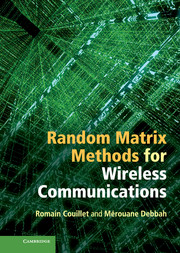Book contents
- Frontmatter
- Contents
- Preface
- Acknowledgments
- Acronyms
- Notation
- 1 Introduction
- Part I Theoretical aspects
- 2 Random matrices
- 3 The Stieltjes transform method
- 4 Free probability theory
- 5 Combinatoric approaches
- 6 Deterministic equivalents
- 7 Spectrum analysis
- 8 Eigen-inference
- 9 Extreme eigenvalues
- 10 Summary and partial conclusions
- Part II Applications to wireless communications
- References
- Index
2 - Random matrices
from Part I - Theoretical aspects
Published online by Cambridge University Press: 07 October 2011
- Frontmatter
- Contents
- Preface
- Acknowledgments
- Acronyms
- Notation
- 1 Introduction
- Part I Theoretical aspects
- 2 Random matrices
- 3 The Stieltjes transform method
- 4 Free probability theory
- 5 Combinatoric approaches
- 6 Deterministic equivalents
- 7 Spectrum analysis
- 8 Eigen-inference
- 9 Extreme eigenvalues
- 10 Summary and partial conclusions
- Part II Applications to wireless communications
- References
- Index
Summary
It is often assumed that random matrices is a field of mathematics which treats matrix models as if matrices were of infinite size and which then approximate functionals of realistic finite size models using asymptotic results. We wish first to insist on the fact that random matrices are necessarily of finite size, so we do not depart from conventional linear algebra. We start this chapter by introducing initial considerations and exact results on finite size random matrices.We will see later that, for some matrix models, it is then interesting to study the features of some random matrices with large dimensions. More precisely, we will see that the eigenvalue distribution function FBN of some N × N random Hermitian matrices BN converge in distribution (often almost surely so) to some deterministic limit F when N grows to infinity. The results obtained for F can then be turned into approximative results for FBN, and therefore help to provide approximations of some functionals of BN. Even if it might seem simpler for some to think of F as the eigenvalue distribution of an infinite size matrix, this does not make much sense in mathematical terms, and we will never deal with such objects as infinite size matrices, but only with sequences of finite dimensional matrices of increasing size.
Small dimensional random matrices
We start with a formal definition of a random matrix and introduce some notations.
Information
- Type
- Chapter
- Information
- Random Matrix Methods for Wireless Communications , pp. 17 - 34Publisher: Cambridge University PressPrint publication year: 2011
Accessibility standard: Unknown
Why this information is here
This section outlines the accessibility features of this content - including support for screen readers, full keyboard navigation and high-contrast display options. This may not be relevant for you.Accessibility Information
- 2
- Cited by
